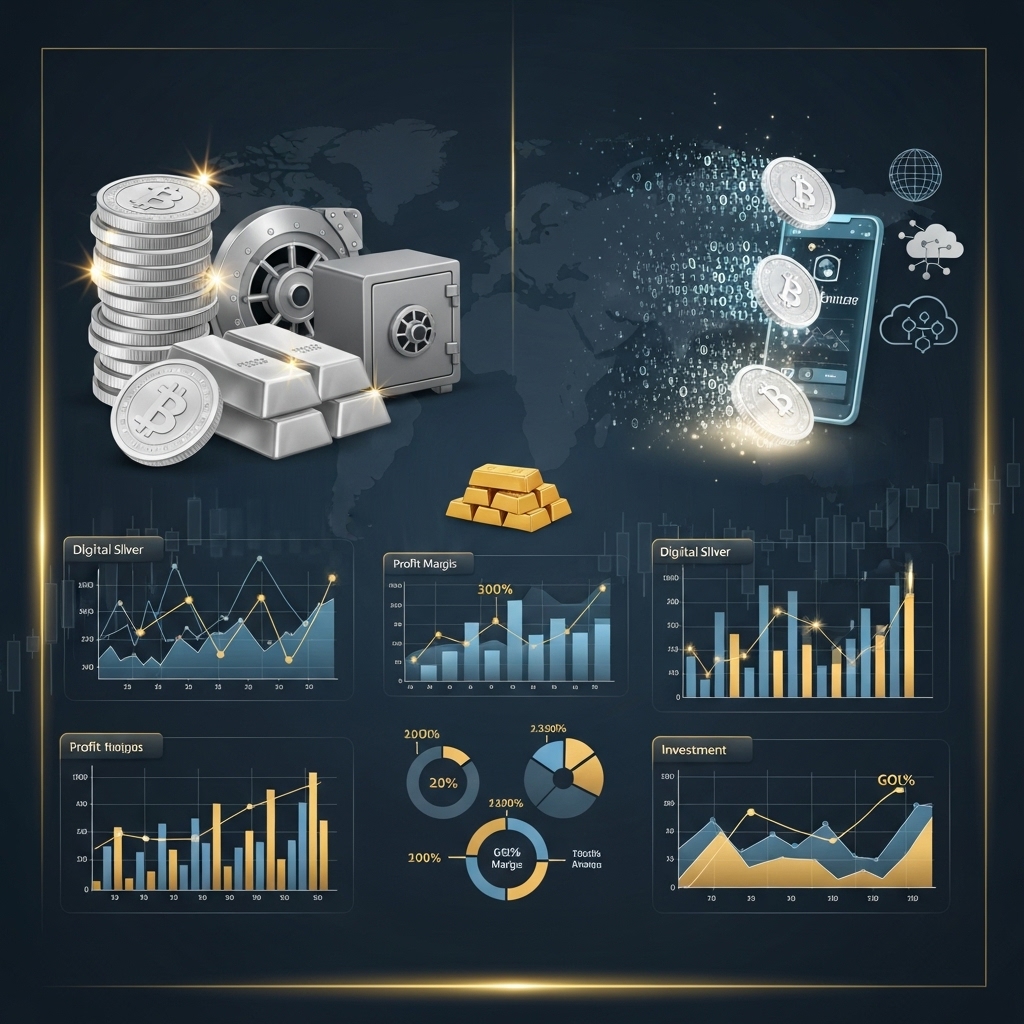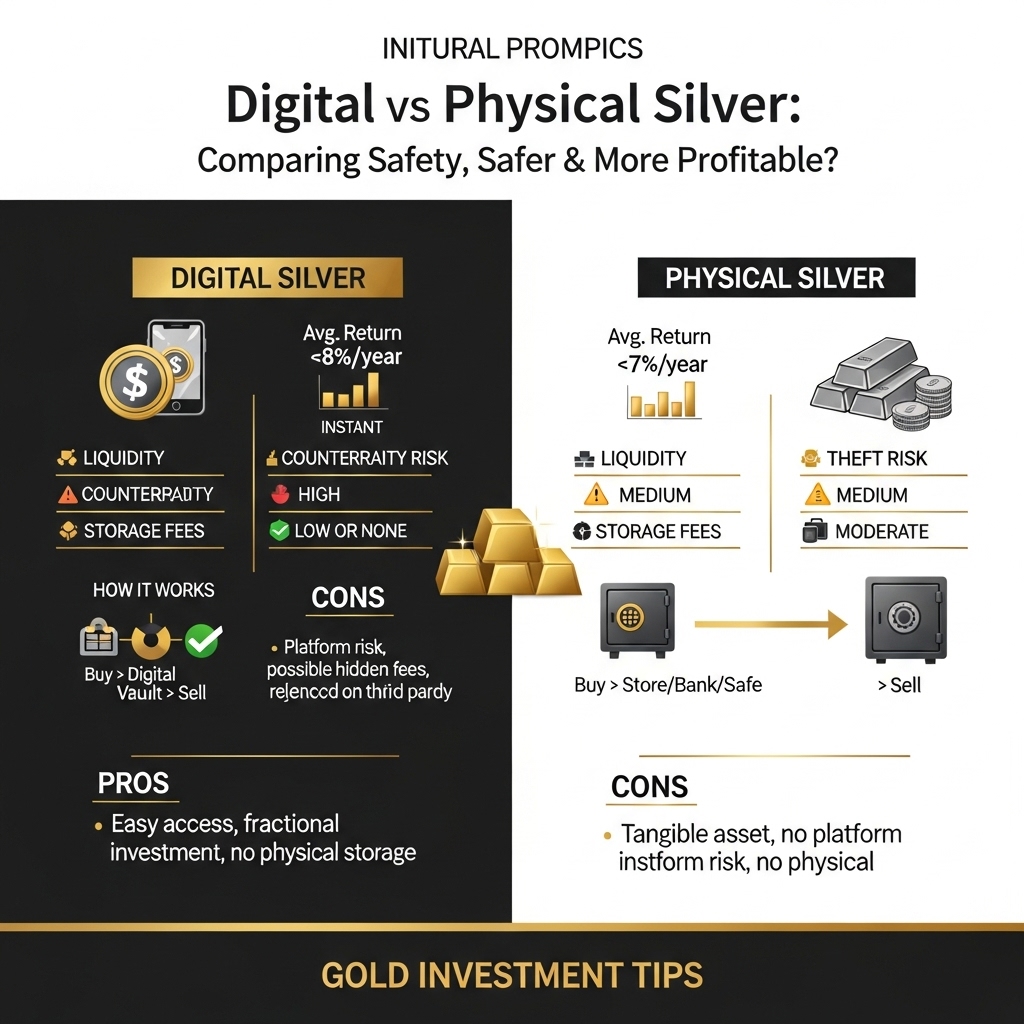Digital vs Physical Silver: Which is Safer & More Profitable?
As gold prices surge to new highs and central banks signal uncertainty, savvy investors are looking beyond gold to diversify their portfolios with precious metals. Silver, known as “the poor man’s gold,” has emerged as an appealing alternative, given its historical role as a store of value and its typically higher price volatility compared to gold. But in today’s rapidly evolving financial landscape, investors face a crucial choice: should you buy physical silver you can hold in your hand, or embrace the convenience of digital silver investments?
In this post, we’ll dive into the heart of the digital vs physical silver debate, breaking down the key factors every gold investor should consider. We’ll compare security, accessibility, storage costs, liquidity, and potential profitability between owning physical silver (coins, bars, bullion) and digital forms (ETFs, online platforms, and digital tokens). You’ll discover up-to-date market trends, the potential risks and rewards of each option, and actionable tips for integrating silver into your investment strategy.
Why does this matter for gold investors? Simply put, market trends are shifting, and diversification is more important than ever. Understanding how silver can complement or contrast with your gold holdings—and which type of silver investment offers the safety and returns you seek—can help you stay ahead in an unpredictable economic climate. Let’s explore which form of silver truly shines for modern investors.
Gold Market Analysis and Key Insights
Current Market Trends and Data
In recent years, gold has solidified its status as a critical safe-haven asset, particularly amid global uncertainties and inflationary pressures. As of Q2 2024, gold prices have steadily hovered near record highs, with spot prices around $2,300 per ounce. This upward trend is attributed to persistent global inflation, geopolitical conflicts, and central banks’ substantial gold purchases—2023 saw central banks buy over 1,000 tonnes, marking a near-record level. Investor demand, both for digital gold products (ETFs, digital certificates) and physical bullion (coins, bars), remains robust. Data from the World Gold Council show that gold-backed ETFs have seen fluctuating inflows, reflecting investor sensitivity to monetary policy expectations and economic outlooks.
Investment Benefits and Considerations
Gold offers unique advantages for investors seeking portfolio diversification, risk mitigation, and a hedge against currency devaluation. Physical gold gives direct ownership, aesthetic value, and protection from digital risks like cyberattacks or platform insolvency. However, it involves storage, insurance, and liquidity considerations. Digital gold, on the other hand, provides ease of trading, lower transaction costs, and accessibility, especially for smaller investors. Yet, digital products introduce counterparty risks—such as reliance on custodians and regulatory frameworks, which may not always guarantee physical gold backing.
In comparison to silver, gold typically experiences lower volatility and stronger long-term value retention. Its deep liquidity and global recognition make it particularly appealing during economic shocks. Expert analyses consistently highlight gold’s ability to preserve wealth over decades, while also noting that short-term profit opportunities can be more dynamic—though riskier—for silver investors.
Expert Recommendations
Leading analysts advocate holding both physical and digital gold as part of a balanced strategy. For safety-focused investors, allocating a portion to securely stored physical gold is advisable. For those emphasizing liquidity and active management, digital gold instruments such as ETFs offer convenience and cost-effectiveness. Experts recommend routine portfolio rebalancing, ongoing due diligence on custodians or platforms, and monitoring macroeconomic triggers like interest rates or geopolitical events. Ultimately, gold remains a cornerstone asset for preserving and growing wealth in a diversified investment portfolio.

Gold Investment Strategies and Options
When considering whether digital or physical gold is safer and more profitable, it’s important to assess the diverse strategies and options available to investors. Physical gold investments involve buying coins, bars, or jewelry. These tangible assets can be securely stored at home, in bank vaults, or with third-party custodians. Physical gold offers complete ownership and is immune to cyber risks, but it does entail storage, insurance costs, and potential liquidity challenges.
Digital gold investments include Gold ETFs (Exchange-Traded Funds), gold mutual funds, and gold savings schemes offered by fintech platforms. These options offer high liquidity, low entry barriers, and easy portfolio rebalancing. However, they come with counterparty risks, such as default risk from the issuer or custodian.
Risk assessment is crucial for effective portfolio allocation. Physical gold provides protection against systemic risks but is less flexible and harder to sell quickly during market upheavals. Digital gold, while convenient, relies on digital infrastructure and the financial health of issuers. As a general guideline, financial advisors recommend allocating 5–15% of a portfolio to gold, balancing between digital and physical formats depending on risk tolerance and investment objectives.
When comparing investment methods, physical gold favors long-term wealth preservation and privacy, while digital gold excels in trading and liquidity. Market timing is also a key consideration; gold prices typically rise during economic uncertainty and inflationary periods. Regularly monitoring market trends or employing systematic investment plans (SIPs) in gold funds can help mitigate timing risks.
Ultimately, integrating both digital and physical gold can offer diversification, harnessing the advantages of each method while managing potential downsides. Tailoring your strategy based on your risk appetite, liquidity needs, and market outlook will protect your wealth and seize profit opportunities.
Market Performance and Outlook
Historically, silver’s value has experienced significant fluctuations, with periods of boom during economic uncertainty and inflationary cycles. Physical silver prices peaked notably in 2011, surpassing $48 per ounce, driven by post-recession instability and monetary easing. Conversely, digital silver—investment platforms offering silver-backed securities like ETFs—has mirrored these movements, but offers the added benefit of instant transactions and decreased storage concerns, making it attractive for modern investors.
Currently, silver trades between $22 and $28 per ounce (as of mid-2024), reflecting ongoing economic tensions, including persistent inflation and geopolitical risks. Physical and digital silver’s price difference, or “premium,” remains moderate, influenced by supply chain constraints and mint production costs for physical bullion. Digital silver is trading near spot prices, making it more liquid and accessible for short-term investors.
Looking forward, analysts predict increased silver demand from both industrial sectors—especially in green technology—and investment channels. Forecasts suggest silver could surpass $30 per ounce by 2025 as economies pivot to renewable energy. Economic factors traditionally affecting gold, such as interest rates, inflation, and currency fluctuation, similarly impact silver, often increasing its appeal during market downturns. These trends indicate that, while both digital and physical silver carry risks, the sector overall remains poised for sustainable growth, with each format offering unique advantages depending on investors’ goals.
Frequently Asked Questions About Gold Investment
What is the difference between digital and physical silver investing?
Digital silver is bought and held electronically via online platforms, while physical silver refers to tangible coins or bars you can store and touch. Digital silver offers convenience and liquidity but may depend on the platform’s reliability. Physical silver gives you direct ownership but needs secure storage.
Is digital or physical silver safer for my investment?
Physical silver is immune to hacking or bankruptcy of an online platform, making it safer from counterparty risks. However, it can be stolen or lost. Digital silver is easier and safer to store but relies on third-party trust and platform security.
Which option offers better profit potential: digital or physical silver?
Both mirror the spot market price of silver, so profits are closely aligned. However, digital silver often has lower transaction fees and tighter spreads, potentially boosting short-term gains. Physical silver may appreciate more in times of supply shortages or crises where physical metal is most in demand.
How liquid are digital and physical silver investments?
Digital silver can be sold anytime through online platforms, offering higher liquidity. Physical silver requires finding a buyer and verifying authenticity, which may slow the sale process and affect pricing.
What are the key risks to consider for both types?
For digital silver, main risks are platform fraud, cyberattacks, and the company’s solvency. For physical silver, risks include theft, storage costs, and authenticity concerns. Diversifying between both may help reduce overall risk.

Final Thoughts on Gold Investment
In weighing digital versus physical silver, gold investors should consider security, liquidity, and market accessibility. Physical silver offers tangible ownership and a hedge against cyber risks, while digital silver provides convenience and easier trading—but may come with counterparty risks. Ultimately, a balanced portfolio that includes both digital and physical precious metals can enhance both safety and profit potential, while still maintaining gold’s core wealth-preserving attributes. For most gold investors, diversifying across both forms of silver—alongside their core gold holdings—offers the strongest protection against volatility and unforeseen events. Ready to strengthen your precious metals strategy? Explore your options, stay informed, and make the investment decisions that best secure your financial future. Share your thoughts or questions below, and let’s keep the conversation going!